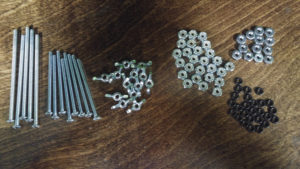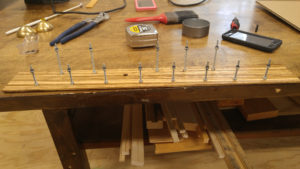I was looking around at Steve Weiss and found these Saucer Bells. These are inexpensive brass bells tuned chromatically from C7 to C8 (the highest octave on a typical glockenspiel or xylophone). Unfortunately, I found they are difficult to play on the string they come delivered on. So I set out to find a stand for them to be set up in a keyboard layout… and didn’t find anything, so I decided to build my own. Apparently, others had the idea before me. Not too surprising.
Originally, I was going to use a 3″ × 36″, 3/16″ thick flat bar of plain steel from Home Depot (which I later talked myself out of), and use #6 machine screws as posts (2 inches for the 8 white keys and 3 inches for the 5 black keys). I was planning to spray paint the final piece of hardware with Rustoleum Oil Rubbed Bronze, like my newly completed chimes stand. However, I ended up changing my mind, because I didn’t want to have to deal with the pain of hacksawing the bar to 24″ (or finding someone to help me). Instead, I found a 3″ × 24″, 1/8″ thick piece of Zebrawood that I plan to use instead of metal. Zebrawood is very hard and very dense, so I am hoping this will be strong enough for the task, even at that thinness, because it will be much easier to work. I will finish it will a clear coat, so it will look nice and pretty too.
I haven’t received the Zebrawood yet, but here are my “plans”.
You might be wondering… why? My tentative plan for these bells are to be a substitute for crotales.
Forgive me for playing them upside down. I was holding the camera with the hand I would have held them with. I’m also using the included tiny mallet, not what you’d typically use on a crotale.
They’re not a perfect substitution; they cost less than 1/10 the price of a Sabian high octave crotales set, but the overtones are somewhat different. I also think it would be more difficult (impossible?) to bow these bells.
In actuality, I’ve never played a set of crotales before. Pensacola State College has crotales, but in other cases, I’ve simply never had any to play. I’ve had few crotales parts before, and I’ve just played those parts on glockenspiel with brass or aluminum mallets. I think these will work much better, and I think the sound difference will be marginal, especially at a distance.
Maybe someday Weiss will sell a lower octave of these.
I’ll update again when I’ve completed the project.
Update for August 21, 2017. The 3″ × 24″, 1/8″ thick piece of Zebrawood arrived today. Here’s what it look like.
Update for August 29, 2017. Here are all the pieces.
Update for September 5, 2017. It looks like we finished the project yesterday on Labor Day.
I got my dad to help me putting all the pieces together. We used his drill press to put in all the holes, and then applied two coats of clear finish to each side of the zebrawood.
Out of the 13 bells, only 2 of them had holes large enough to fit the #6 machine screws. The others needed a little drill press to remove some protruding brass from the edges.
Putting on the lock nuts was actually pretty tricky, since you can’t tighten them by hand. For the nut holding each screw in place, I held the nut tight while dad used a phillips head bit to drive the nut down. For the locking nut that holds the bell in place, this was much easier since we could just use a socket bit. Getting them all the same height, more or less, was the only tricky part. I then added one #60 o-ring to the top of each.
Then I added each bell, another o-ring, and the wing nut to each of the 13 posts.
From there, the entire piece did go onto a cymbal stand, but the right side bowed a bit under the weight of the bells. To fix this, we added a strip of hardwood underneath to give it a bit more stability.
So… the problems are… (1) The instrument doesn’t fit perfectly on a cymbal stand. It doesn’t quite fit around the bottom felt, so I remove that one and just have the top felt. (2) The instrument isn’t balanced, but this seems mostly fixed with the extra support from the bottom hardwood. (3) The instrument isn’t particularly easy to play. The best strike zone for the bells is actually on the sides, not the top. I can turn the instrument slightly back to make it easier, but this is a little tricky since it isn’t balanced. The cymbal stand itself needs to be sturdy too.









